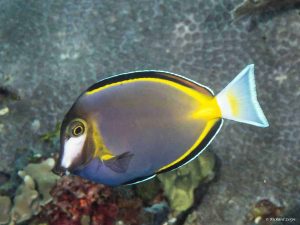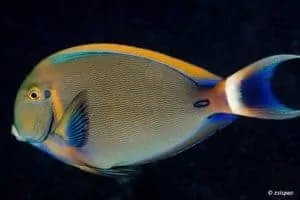Acanthurus blochii – Ringtail Surgeonfish
Acanthurus blochii was first described in 1835 by Valenciennes. Their common name is Ringtail Surgeonfish or Tailring Surgeonfish.
Description
The color of Acanthurus blochii is blue / gray. Underwater they can look very dark, almost black. You often see a little yellow around the eye with a yellow spot just behind the eye. Their common name Ringtail Surgeonfish refers to the white band on the caudal penducle that is often visible. Their scalpel is very dark. They can reach a total length of around 50 centimeters.
There are two species that are very similar to Acanthurus blochii. Acanthurus auranticavus also has a white band on the caudal peduncle but lacks the yellow spot behind the eye. Acanthurus dussumieri also looks similar but has a light-colored scalpel.
Origin
The distribution area of Acanthurus blochii is huge. They occur from the East African coast to the Hawaii islands; they inhabit the Indian Ocean, Pacific Ocean and intervening seas. From the south of Japan to the north coast of Australia.
The adults usually live in the outer edges of lagoons and coral reefs towards the sea. They live in the relatively shallow parts at a depth of around 2 to 15 meters. They usually form small groups but at certain locations they can also form large schools.
Diet
The diet of this species mainly consists of algae that grows on sand. While feeding on the algae they also eat sand grains that probably helps with digesting the algae. In addition, they feed on diatom and detritus. In the aquarium you can feed them with algae, artemia, frozen food, flake food and zooplankton.
The aquarium
It will not come as a surprise that this species needs a large aquarium. With a total length of up to 50 centimeters, an aquarium of at least 2,000 liters is required. Due to their diet of mainly algae, only add them to a well-established aquarium in which algae and sand can be found. It is not a species for the beginner. They are difficult to keep healthy.
Like many other surgeonfishes, they can be aggressive towards conspecifics in the aquarium.
Warning
This species has a razor-sharp blade at the base of its caudal fin. These retractable scalpel-like prongs are a natural way to defend themselves. They only unfold when the fish is excited or feels threatened. However, they can cause very deep flesh wounds, often leading to infections. The infections are characterized by swelling and discoloration of the wound. This can last for several hours. Due to the infections caused by scalpel wounds, it is suspected that they have venom glands.
Breeding Acanthurus blochii – Ringtail Surgeonfish
As far as is known, Acanthurus blochii is not bred in captivity.
Video
Copyright images
Resources







Reviews
There are no reviews yet.